Feeding Birds in Summer: Insights and Best Practices
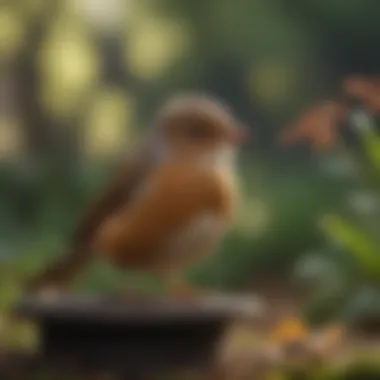
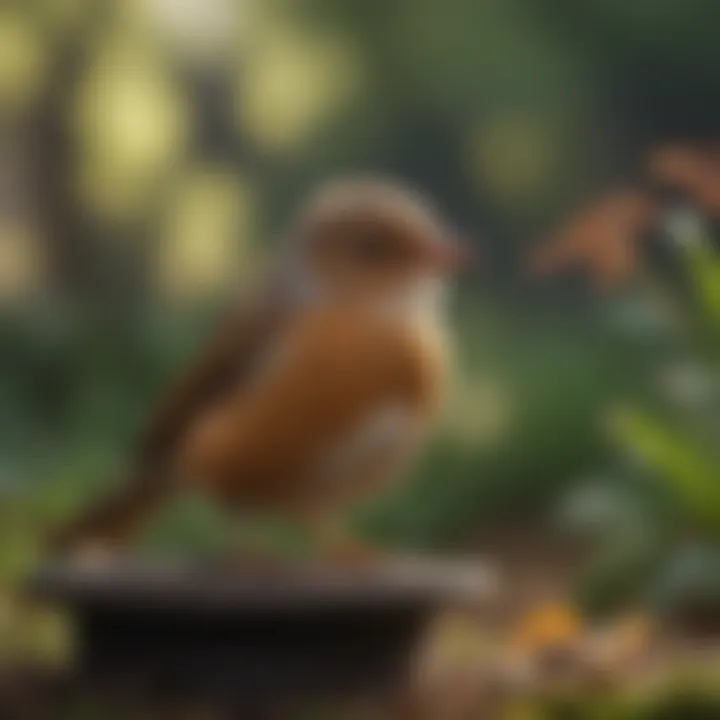
Overview of the Topic
Feeding birds during the summer months may seem like a curious endeavor. Unlike winter, when a lack of food sources drives many people to fill feeders, summer offers a variety of natural provisions for our feathered friends. However, it is crucial to understand that avian nutrition varies greatly across the seasons, necessitating a deeper examination of how best to support birds during this particularly vibrant but challenging time. The summer months bring unique opportunities to enhance bird wellbeing while minimizing negative ecological impacts.
In recent years, a growing awareness about the interrelation between human activities and environmental integrity has emerged. This has given rise to discussions about responsible bird feeding and the roles it plays in the larger ecosystem. Knowing what to offer and when can significantly affect bird health and even influence local biodiversity. Understanding these nuances equips individuals with the knowledge to turn their backyards into havens for diverse bird species.
Current Status and Challenges
Today, the relationship between birds and their surrounding environment is under strain. Urbanization, habitat loss, and climate change are at the forefront of threats faced by these avian populations. Many birds rely on summer as a critical period for mating, nesting, and raising young. Unfortunately, food availability can fluctuate significantly due to these environmental pressures. An examination of the current state highlights the following:
- Nutritional Needs: Roadblocks such as declining insect populations can limit vital protein sources for growing chicks.
- Habitat Alteration: Changes in land use can reduce foraging opportunities, putting additional pressure on local bird populations.
- Weather Extremes: Unpredictable weather patterns make it difficult for birds to locate food sources reliably.
Understanding these threats not only sheds light on the complexities of bird feeding practices but also emphasizes the need for targeted actions to help counter these challenges.
Sustainable Solutions
To navigate the complexities of bird feeding, it’s essential to adopt sustainable practices that not only support birds but also protect our environment. Some actionable strategies include:
- Plant Native Species: Cultivating native plants is a prime way to create welcoming habitats that naturally supply food and shelter. Plants like coneflowers and sunflowers attract pollinators and provide seeds for birds during the summer.
- Quality Feed: If bird feeders are to be used, focusing on high-quality seed mixes that include sunflower seeds and peanuts can help meet the protein and fat needs of various species.
- Water Sources: Setting up shallow bird baths can provide essential hydration, especially during hot spells. This simple act can significantly enhance the well-being of local birds.
Showcasing successful community efforts can inspire others. Local initiatives that focus on creating bird-friendly zones and encourage participation in citizen science projects can significantly impact awareness and conservation efforts.
Impact and Importance
Feeding birds in summer does not just serve the immediate need to attract species; it weaves into the broader tapestry of ecological health. Engaging responsibly can lead to:
- Biodiversity Enhancement: Supporting local birds through proper feeding can help maintain and even increase local biodiversity, resulting in healthier ecosystems.
- Education and Awareness: Feeding initiatives can serve as educational platforms that foster appreciation for nature amongst communities.
- Long-term Conservation: By understanding the significance of bird feeding in the summer, we foster a sense of stewardship that can encourage long-term conservation practices.
"When people feed birds responsibly, it becomes a part of the ecological dialogue, weaving together community health and environmental awareness."
For further reading on avian ecology and bird feeding best practices, visit Wikipedia or check out more information at Britannica.
Foreword to Bird Feeding
Bird feeding often conjures images of winter scenes, with birds flitting to and fro at feeders piled high with seed. However, the summer months hold their own intricacies when it comes to avian nourishment. As the weather warms, many people begin to wonder whether maintaining feeding stations is still appropriate or necessary. Understanding this topic is critical for those interested in enhancing biodiversity and conserving our feathered friends.
Feeding birds in summer is not merely a learned habit passed down through generations; it represents a significant opportunity to provide essential support during a time when natural food sources may become scarce, especially as breeding birds seek the energy they need to raise their young. The sheer joy one receives from observing birds in their natural habitat is a bonus, enhancing outdoor experiences.
Consider this: Providing food can create an intimate connection between humans and wildlife. It facilitates a delightful engagement with nature. More than just giving birds a meal, this act shows an investment in their well-being and habitat conservation. Furthermore, it encourages understanding of local species and fostered greater awareness about ecological balance.
Key factors to ponder in this section include not only the nutritional requirements of birds during summer but also the environmental implications involved in this practice.
Understanding the Avian Dietary Needs
Birds, by nature, display an extensive variety in terms of dietary preferences, ranging from seeds, fruits, insects, and nectar. During summer, many species shift their dietary focus to maximize the benefits they can draw from the diverse range of available food.
For instance, insectivorous birds, like the Eastern Bluebird, primarily feed on insects, which provide the high protein required for their chicks. Likewise, species such as American Goldfinches turn to seeds and other plant materials as they nest. Birds often require a more varied diet when raising young, which can lead to shifts in feeding behavior as they continuously seek out optimal food sources.
Understanding these nuances helps bird feeders to offer more tailored options. This can mean supplementing seed mixes with dried mealworms or providing fruit options to cater to insectivorous and frugivorous species. Adjusting feeders accordingly ensures that birds have access to necessary resources.
Importance of Seasonal Feeding Patterns
The essence of seasonal feeding extends beyond mere sustenance. It reflects the rhythms of nature, serving as a blueprint to understand avian behavior and ecological interactions. Summer, in this context, is a pivotal time when birds ramp up their feeding efforts to bolster energy levels and successfully rear their offspring.
During these months, many birds establish feeding territories while also looking for reliable food sources to support their growing families. It's crucial to recognize that while nature can provide many resources, it can also present challenges. Depending on the climate and geographical area, resources may become constrained due to heat, drought, or competition among other species. These conditions can lead to increased mortality rates among young birds.
"Birds don't take a holiday in summer; they need our support just as much as in winter."
With keen awareness of this, backyard bird enthusiasts can adjust their practices seasonally, ensuring they provide food and water resources, upping the chances of survival for young, developing birds. Overall, seasonal feeding helps establish a solid connection between community efforts and bird conservation.
Bird feeding during summer is a complex interplay between ecology and the needs of our avian friends. By understanding their dietary needs and the importance of feeding patterns throughout the seasons, we not only create a supportive environment for birds but also enrich our interactions with nature.
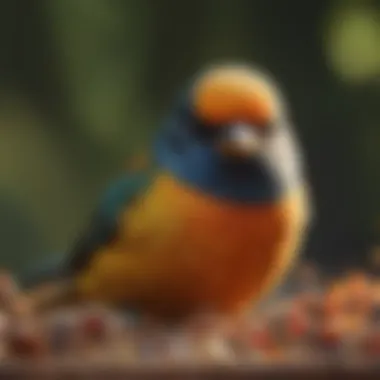
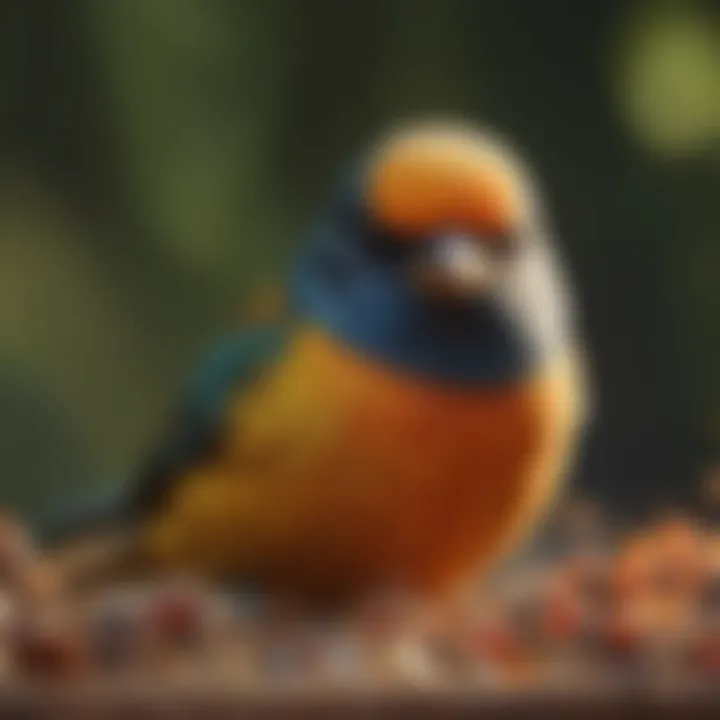
The Ecology of Summer
Summer, with its lush greenery and bustling wildlife, is a critical time for understanding the ecology of bird feeding. The seasonal shift brings a myriad of challenges and opportunities, significantly impacting the birds’ survival strategies and dietary needs. By recognizing these ecological elements, bird feeders can make informed choices that not only benefit avian visitors but also promote a balanced ecosystem.
When thinking about the importance of the ecology of summer, it’s essential to grasp the intricate relationships that dictate avian habits and their basic needs. Adapting to temperature variations, food scarcity, and changes in breeding cycles, birds rely heavily on their environment. Every decision made in how we feed them during summer should intertwine with these natural rhythms, ultimately ensuring that our actions benefit rather than harm them.
Food Sources Available in Nature
During summer, nature brims with vibrant food sources for birds. Insects, seeds, fruits, and nectar become plentiful, each providing different types of nutrients essential for a bird's well-being. The presence of insects takes center stage as countless species emerge, offering a protein powerhouse to feeding birds, particularly during the breeding season when energy demands soar.
This time of year also gives rise to bountiful seeds from grasses and wildflowers, along with ripening fruits such as berries and cherries. These foods not only allure various bird species, including finches and thrushes, but also support their fledglings. Landing a favorite spot where these natural food sources are ripe can turn a yard into a haven for colorful songbirds.
Nevertheless, it’s vital to consider how supplementing their diets can intersect with the abundance provided by nature. Depending only on bird feeders doesn't equate to a well-rounded diet, and that could lead to health issues. Understanding this balance can ensure responsible feeding habits while promoting vital bird populations in the area.
Behavioral Adaptations in Warmer Months
Birds exhibit fascinating behavioral adaptations in response to the sweltering summer months. One might observe changes in feeding patterns, nesting behaviors, and even how they interact socially. For example, many birds become quite selective, tending to choose specific foods that provide the necessary energy levels needed for the season's heightened activity.
Social structures might also shift, with communal feeding becoming more prevalent as birds form flocks. This often enhances their foraging efficiency, making it easier to locate food sources. Furthermore, the vocalizations of birds often evolve during the summer, as they communicate during breeding and territorial disputes.
Some key adaptations include:
- Hydration seeking: Birds often look for resources with sufficient moisture to avoid dehydration.
- Foraging flexibility: They might switch from one food source to another based on availability, demonstrating their adaptability.
- Nesting adjustments: Some birds may choose to nest in more humid areas to mitigate the harshness of the heat.
In summary, understanding the ecology of summer helps demystify the birds' intricate lives. The food available and the adaptations they employ are not merely factual nuggets; they form the framework upon which feeding practices can be built. By aligning our actions with nature's blueprint, we ensure that our feathered neighbors can thrive while fostering an appreciation for the delicate balance of their ecosystem.
Arguments For Feeding Birds in Summer
When it comes to the practice of bird feeding, many people think about cold winter months. However, summer holds its own set of distinct advantages that merit a thorough examination. To ignore feeding during this season is to overlook a critical time for many species that depend on supplementary resources to ensure their survival and reproductive success. In this section, we will explore the reasons why providing food for birds during the warmer months is beneficial, both for the birds and for the ecosystems they inhabit.
Supplementing Natural Food Supplies
During summer, birds face a host of challenges in finding food. Natural food sources may dwindle due to competition among large populations of birds or environmental factors like droughts and heatwaves. Certain species, especially in urban areas, might struggle to locate enough high-quality nutrition months to prepare for breeding. By offering feeders filled with high-quality seeds or nuts, you can fill this gap and provide crucial sustenance at a pivotal time of the year.
"Many birds engage in intense foraging activities during summer months, and those who struggle often face dire consequences."
Supplementing their natural diet can help reduce the stress on bird populations. Some feeders offer specific types of food that encourage particular species to visit; for instance, sunflower seeds draw in chickadees and cardinals. This not merely benefits the birds but can also enhance one’s experience as a birdwatcher, adding color and life to any backyard or outdoor space. Moreover, providing a diverse range of supplies means you widen the variety of species that might be attracted, enriching the avian tapestry of your environment.
- Consider adding:
- Sunflower seeds: Rich in healthy fats, great for energy.
- Suet cakes: Perfect for woodpeckers and other insect-eating birds.
- Nectar: For those beautiful hummingbirds that brighten gardens.
As you provide these foods, keep in mind that fresh options often attract birds far better than stale or outdated supplies. Keeping feeders clean and replenished not only shows care but also encourages frequent visits.
Supporting Breeding Success
Summer is a critical period for avian reproduction. Many species are nesting, raising young, and preparing for migration in the latter part of the season. Offering food during this time can directly affect the health and survival rates of chicks. Nestlings require a high-protein diet to grow strong and vibrant, and supplementing parents' efforts can contribute to higher survival rates among fledglings.
Birds like the American Robin and the Eastern Bluebird often rely on insects to feed their young. If natural insect populations fluctuate, which often happens during hot spells, having feeders available means that parent birds can easily access the energy they need to find other food or nest more effectively.
- Supporting breeding success in birds involves:
- Reducing foraging effort: Parents can spend less time looking for food.
- Increasing chick survival: Healthy, well-fed parents are more likely to rear healthy offspring.
- Attracting diverse species: A well-fed environment is inviting for multiple bird families.
Observing birds raising their young can be one of the most rewarding aspects of summer bird feeding. It imbues your outdoor space with life and vibrancy, allowing for greater appreciation of the cycles of nature. By proactively supporting birds in these ways, you contribute positively to both their lives and your surroundings, fostering delicate ecosystems that thrive on ecological harmony.
Arguments Against Feeding Birds in Summer
Feeding birds in the summer might seem like an act of kindness, but there are several compelling arguments against this practice that merit a careful discussion. As the warmer months usher in a flurry of avian activity, it’s crucial to acknowledge potential risks associated with human intervention in their feeding routines. By exploring these arguments, we can better understand how our actions might inadvertently disrupt the natural balance of avian life.
Potential Dependency on Human-Provided Food
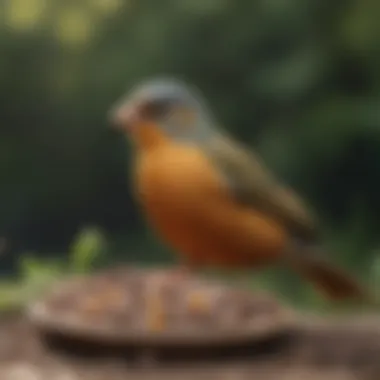
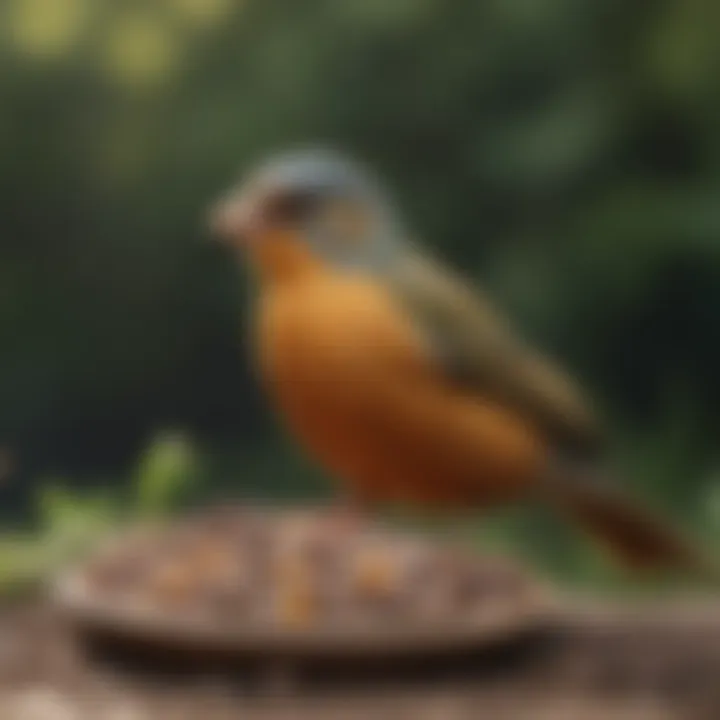
One of the foremost concerns regarding summer bird feeding is the possibility of fostering a dependency on human-supplied food sources. While it may seem harmless to offer a few sunflower seeds or suet cakes, this can lead some birds to rely excessively on these offerings. When birds become accustomed to being fed, they may neglect their instinctual foraging behaviors. This phenomenon can particularly impact fledglings or inexperienced birds that rely on learned behaviors from their parents.
For instance, consider a blue jay that has grown used to visiting a backyard feeder. If this bird becomes too reliant on the feed, it might overlook natural food sources like acorns or insects. Such dependency can have cascading effects on the bird's health, especially if the provided diet lacks essential nutrients that their wild counterparts would typically forage from their environment.
"Nature has a way of balancing itself—interfering might tip the scales in unpredictable ways."
Risks of Disease Transmission
Another significant concern surrounding summer bird feeding involves the risk of disease transmission among avian populations. Just like humans, birds can carry and spread diseases, particularly when they congregate around feeders. High bird traffic increases opportunities for pathogens to spread through droppings, shared food, or even physical contact.
Some common diseases that can be exacerbated by crowding at feeders include:
- Salmonellosis: This bacterial infection can be fatal to birds and is often transmitted through contaminated food.
- Avian pox: A viral infection that leads to skin lesions and can spread easily when birds feed in close proximity to one another.
Moreover, during the warmer months, conditions are ripe for pathogens to flourish. Milder temperatures and moist environments can expedite the growth of bacteria and fungi on bird feeders. Therefore, it's essential to maintain clean feeding stations, but the question remains whether it's responsible to introduce more risks into the ecosystem.
Finale
While feeding birds in summer might appear altruistic, the arguments against it compel us to think critically about our actions. Creating dependencies and inadvertently facilitating disease spread contradicts the goal of promoting avian health and well-being. Thus, it becomes vital for bird lovers to weigh these considerations carefully, perhaps choosing to observe and appreciate birds in their natural foraging environments instead.
Best Practices for Feeding Birds
Feeding birds in summer can be a delightful experience, but it's crucial to approach it with informed strategies. Best practices for feeding birds not only ensure that our feathered friends benefit but also keep in mind the balance of local ecosystems. Understanding how to properly feed birds can lead to healthier birds and a more vibrant environment.
Choosing Appropriate Feeders and Foods
Seed Types and their Suitability
Selecting the right seeds plays a critical role. Different bird species have unique dietary preferences, which means one size does not fit all. For instance, sunflower seeds are a crowd favorite among many species, especially cardinals and finches. Their high oil content provides essential energy for birds during the hot summer months.
However, one should also consider that not all seeds are created equal. Some, like thistle seeds, cater specifically to smaller birds such as goldfinches. When you choose seed types, it is beneficial to mix different varieties to attract a broader range of birds. This not only brings diversity to your backyard but helps meet various birds' needs.
Ultimately, understanding the nutritional value of the seeds you offer can vastly improve the health of the avian visitors. While some seeds are nutrient-poor and can be considered fillers, others, like millet and safflower, are more nutrient-dense and can help support breeding and fledging young.
Nutritional Additives and Supplements
Incorporating nutritional additives can be a smart way to enhance the diets of the birds visiting your feeders. These can include mealworms, a source of protein that attracts insect-eating birds like robins and bluebirds. When these supplements are available, they can help to nurture birds, particularly during the rearing of their young.
Moreover, adding fat-based foods like suet can provide an excellent energy source. Suet is especially popular among woodpeckers and nuthatches. However, it’s essential to ensure that these supplements are appropriate for the time of year and the species you're aiming to attract; not all birds will consume these extras.
"The right sustenance can make the difference between a thriving bird population and a struggling one, especially during the demanding summer months."
Timing and Frequency of Feeding
Understanding when to feed birds is just as important as what to feed them. During summer, birds have increased activity levels, so ensuring food is available at peak times, such as early morning and late evening, can keep them returning to your feeders. A daily routine of refilling feeders can prevent competition and ensure that all birds have access.
Furthermore, consider establishing a consistent schedule. Birds are creatures of habit and will often return at the same time each day. By adhering to a reliable routine, you make it easier for them to depend on your feeders without neglecting their instinct to forage in their natural habitat.
In summary, the right feeding practices will not only serve the birds but also offer you a rewarding way to connect more intimately with nature, consequently enhancing your garden or yard's biodiversity.
Creating a Bird-Friendly Environment
Creating a bird-friendly environment is crucial for anyone looking to support the avian community throughout the summer months. Unlike winter, when birds rely heavily on provided feeders, summer brings an opportunity to foster a space where they can thrive naturally. A well-designed habitat contributes to the birds' overall health and promotes biodiversity. It’s about more than just putting out crumbs; it’s a way of nurturing a vibrant ecosystem right in your backyard.
One core aspect of this environment is the availability of native vegetation. By choosing the right plants, you invite a variety of bird species in. Moreover, addressing water sources—whether a simple birdbath or a pond—creates a haven that supports hydration and bathing, which are essential for birds in hot weather. Let’s explore these elements further.
Planting Native Vegetation
When it comes to planting, native vegetation is your best friend. Birds have evolved alongside local plants, and they depend on these varieties for food and shelter. Imagine shrubs laden with berries, trees that offer seeds and protective canopies, and flowers that attract insects—each plays a role in drawing birds to your space.
- Benefits of Native Plants:
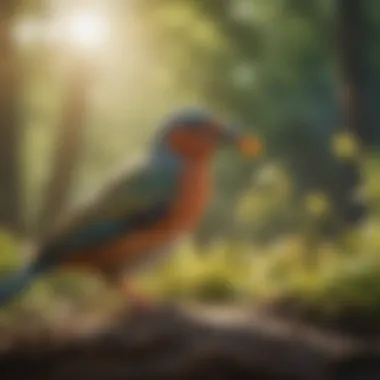
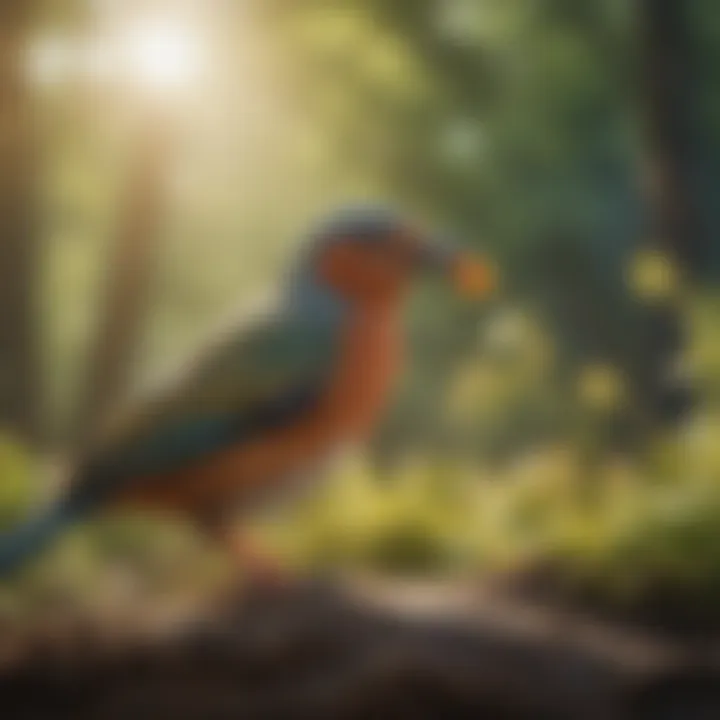
- Diverse Food Sources: Birds feast on berries, seeds, and insects that these plants provide. Native plants are often more nutrient-dense for avian diets than exotic species.
- Natural Shelter: Nesting sites and shelters from predators are effortlessly incorporated into landscapes filled with native trees and bushes.
- Ease of Maintenance: Generally, native plants require less water and care once established, making them a sustainable choice for a hassle-free garden.
To get started, consider planting:
- Dogwoods for their berries enjoyed by many bird species.
- Goldenrods that attract insects which birds can feast on.
- Milkweed, a magnet for pollinators, thus drawing insect-eating birds.
Planting a mix of these will not only beautify your space but vastly improve its value to birds.
Providing Water Sources
Water is life, and for birds, especially during the sweltering summer months, having accessible water sources is indispensable. Birds need water not only for drinking but also for bathing, which helps them maintain their feathers and keep them waterproof.
- Types of Water Sources:
- Placement Considerations:
- Birdbaths: A simple, shallow birdbath can make a world of difference. Ensure the water is refreshed daily to prevent any stagnation.
- Fountains: The sound of running water can attract birds. Plus, moving water discourages mosquito breeding, which is an added benefit.
- Ponds: A small pond with native plants can create a mini ecosystem, supporting a range of wildlife.
- Position the water source in a visible spot, protected from potential predators. Trees or shrubs nearby can provide escape routes for birds if danger looms.
- Ensure that the water source is shallow enough to prevent drowning, particularly for smaller birds.
As you incorporate water into your bird-friendly environment, it’s vital to maintain cleanliness to avoid disease spread. A dedicated water supply will undoubtedly draw in a variety of species, invigorating your backyard.
"A diverse habitat is the heartbeat of any thriving avian community. By planting strategically and ensuring ample water, you not only attract birds but also assist in local conservation efforts, enhancing ecological balance."
By focusing on these elements of a bird-friendly environment, you’ll not only witness an increase in avian visitors but also contribute to broader ecological health. This interplay between nature and human effort showcases how even small spaces can have a big impact.
Monitoring and Evaluation
Monitoring and evaluation play a crucial role in understanding the dynamics of bird feeding during the summer months. This practice involves a systematic approach to observe bird behavior, assess changes in populations, and adapt feeding strategies accordingly. The implications of monitoring can not only enhance the success of attracting birds but also contribute significantly to their understanding and conservation.
Observing Bird Behavior and Populations
Observing birds can be likened to watching a well-rehearsed play, where every action tells a story. By closely monitoring how birds interact with feeders and each other, one can gather invaluable insights about their preferences and needs during the hot months.
- Feeding Preferences: Different bird species have varied tastes. Some may flock to sunflower seeds, while others prefer suet or nectar. Notice which species are visiting your feeders and their feeding frequencies. This can enhance your feeder selections in the future.
- Behavioral Patterns: Keep an eye on how birds react during peak feeding times. Is there a rush at dawn as they start their day? Or perhaps a slow trickle in the afternoon? These patterns can help optimize when to replenish feeders.
- Breeding Activities: Observing nesting behaviors and parental activities provides context to their feeding habits. Knowing which species are breeding can influence the types of food offered, as young birds may require different nutrients compared to adults.
Adjusting Practices Based on Findings
The adaptability to adjust feeding practices based on observations is vital for any bird enthusiast. If certain birds are not showing up, it might be time to reconsider your approach. Here are key considerations to keep in mind:
- Food Types: If you observe a decline in visits from specific birds, it could signal that you need to diversify your offerings. Providing a variety of seeds and foods can cater to a wider range of species.
- Feeder Placement: If certain areas are more active than others, it may be worth relocating feeders. The right balance of sun and shade can make all the difference, especially in the scorching summer.
- Seasonal Adaptations: As summer progresses into late summer or early fall, avian needs might shift. Adjusting your feeding habits in response to seasonal changes enhances the chances of attracting more birds and supporting their dietary requirements.
"The key to successful bird feeding lies in understanding, observing, and adapting to the continuous evolution of bird behavior."
Monitoring and evaluation create a foundational loop of knowledge. As you watch the birds, heed their signs, and adjust accordingly, you forge a connection that not only benefits the birds but enhances your overall experience as a caretaker in their summer haven.
End: Informed Decision-Making
In the realm of bird feeding during summer, understanding the nuances of decision-making is essential. This article sheds light on several important considerations that all enthusiasts should be aware of. Proper planning and informed choices directly impact the well-being of avian species and the integrity of local ecosystems.
Taking the time to weigh the pros and cons—a fundamental aspect of responsible bird feeding—ensures that the actions taken support rather than hinder nature. For instance, while providing food can help birds during times of scarcity, one must be vigilant about the potential drawbacks, such as creating dependence or spreading disease. Effective feeding strategies are not just about dropping some seeds in a feeder; they require ongoing evaluation and a commitment to adaptability based on the seasonal behavior of birds.
Striking a Balance
Finding a middle ground is crucial. Striking a balance means providing assistance to birds without overriding natural foraging instincts. It's about understanding when to supplement their diet and when to step back. For instance, songbirds like finches or robins may increase their reliance on bird feeders if food becomes scarce due to drought. However, overfeeding can lead to overcrowding, which may, in turn, cause disease to spread among the birds.
- Conduct Regular Assessments: Keeping an eye on the health and behavior of local bird populations allows you to adjust your feeding practices as necessary.
- Observe Feeding Patterns: Pay attention to when birds are natural foragers. Consider scaling back during peak food availability.
- Prioritize Natural Resources: Encourage native plants and food sources in your landscape to help birds thrive in their natural environment.
By thoughtfully considering these factors, bird enthusiasts can create a supportive environment that nurtures avian life.
Role of Individuals in Bird Conservation
The role individuals play in bird conservation cannot be underestimated. Each decision made at a personal level contributes to the larger picture of environmental stewardship. Sustainable bird feeding practices are just one step towards fostering biodiversity and protecting habitats.
Even small acts can yield significant benefits:
- Choose Native Plants: Incorporating native flora in your backyard can provide shelter and natural food sources.
- Remove Chemicals: Avoid pesticides that could harm birds and other wildlife.
- Participate in Citizen Science: Engage with local conservation efforts or bird counts, which help track populations and demographics, contributing valuable data to researchers.
"It's the individual actions, collected together, that forge a path to sustainable ecosystems."
The choices made by every person influence not only the surroundings they interact with but also the wildlife that depends on those environments. When the focus shifts toward mindful bird feeding and habitat preservation, the combined efforts create a ripple effect, encouraging others to follow suit. Through education and awareness, individuals can become advocates for avian well-being and biodiversity at large.



